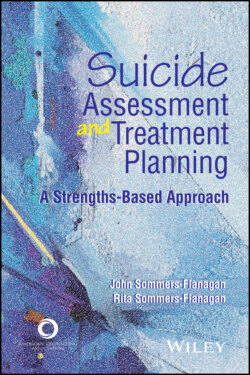Читать книгу Suicide Assessment and Treatment Planning - John Sommers-Flanagan - Страница 54
Is Serena Suicidal?
ОглавлениеSchool counselors and school mental health professionals gain information about students in many different ways. In an ideal world, Serena would approach you, acknowledge suicidal ideation, and ask for help; you would responsibly follow your district’s policy for informing your school administrator, contacting the parents, providing referral information, and staying in touch with Serena via your school’s suicide-related case management protocol. Unfortunately, the opposite process may unfold. You may hear about Serena’s suicidality through her friends or via a teacher. Serena may never approach you and may not be honest with you about her suicidal ideation. To complicate matters further, your district policy may be enigmatic or excessively detailed, Serena’s parents may be unreachable or overreactive, referral resources may be nonexistent, and you may not have a case management protocol for students who are suicidal.
In an article in the American School Counselor Association’s magazine (ASCA School Counselor), Carolyn Stone (2018) described school counselors’ responsibilities for reporting suicidal ideation. Her article included the following points:
1 If you learn that a student is thinking about suicide, contact the parents or other appropriate adults: “Regardless of whether or not we have a state statute to guide our behavior, we must make certain everyone in our profession understands calling parents whenever we are placed on notice that a suicide is even a remote possibility is not an option or judgment call but an absolute duty” (para. 9).
2 Do not trust suicide assessment as a reliable method for determining student risk: “Assessments requiring school counselors to quantify the risk (high risk, medium risk or low risk) based largely on student response is frightening. This is a dangerous practice, and school counselors should consider the information gleaned from a student’s self–report as unreliable. To tell a parent the risk is low is to create for a parent a false sense of security when the student may have hidden the real truth” (para. 13).
3 Lean toward trusting peer reports over student self-report: “It is a well-known fact that students will say and do whatever they need to if they want to get out from under the school counselor’s gaze. Student self-report is not reliable. Peer report is often much more reliable as students will be honest with peers if they are determined to hide their pain from adults” (para. 16).
4 If you are required to conduct an assessment, “use assessments as a segue to provide parents everything learned from the assessment, to urge further evaluation, to stress monitoring of their child’s safety and to provide resources for mental health” follow up (para. 15).
5 Call parents, emphasize risk, provide resources, and arrange for the student to be safely transported home: “School counselors are clear with parents/guardians about a child’s expressed, implied or veiled suicidal ideation. This is not the time to soften the message. School counselors stress to parents that expressions of suicide or other warning signs require vigilance. School counselors confer with the appropriate school officials to make certain the student stays in protective custody and is not dismissed to take whatever means the student normally uses to get home” (para. 24).
6 If necessary, contact child protective services to possibly open a neglect case: “If the parents/guardians intentionally do not seek help for their child with the first notice, the standard of care for the profession is that the school counselor makes an outreach to the family reiterating the suicide risk, the urgency to seek help for their child and the acknowledgement that a neglect case has to be lodged with” child protective services (para. 24).
Stone (2018) and the American School Counselor Association (2020) make it clear that whenever suicide is linked to a specific student, professional school counselors are mandated reporters. Although school counselors may participate in formal suicide assessment protocols, if suicidal ideation is reported, parents or caregivers are contacted. The clarity of this position relieves the school counselor of uncertainty. However, this black-and-white guidance on suicide reporting leaves some school counselors wishing they could exercise their judgment. Given that reporting suicidal ideation to parents or caregivers can rupture the therapeutic relationship and initiate a cascade of negative responses, some professionals question the need for school counselors to always report even minor suicidal ideation.
The reason why school counselors need to report is probably best summed up by the Latin phrase in loco parentis, which means “in place of a parent.” Essentially, when parents are not present, school professionals assume and discharge parental duties. When it comes to suicidal ideation, most professionals, including attorneys, are likely to interpret this principle as meaning that parents or caregivers deserve to be informed when their children talk about suicide. The way we think of this is that school counselors and other professionals working with children should view suicidal ideation as a sign of intense distress, and unless there is evidence of child abuse, parents should be informed when evidence indicates their child is in intense distress. Furthermore, a useful frame to take with parents is to identify support and/or interventions designed to decrease student distress.
